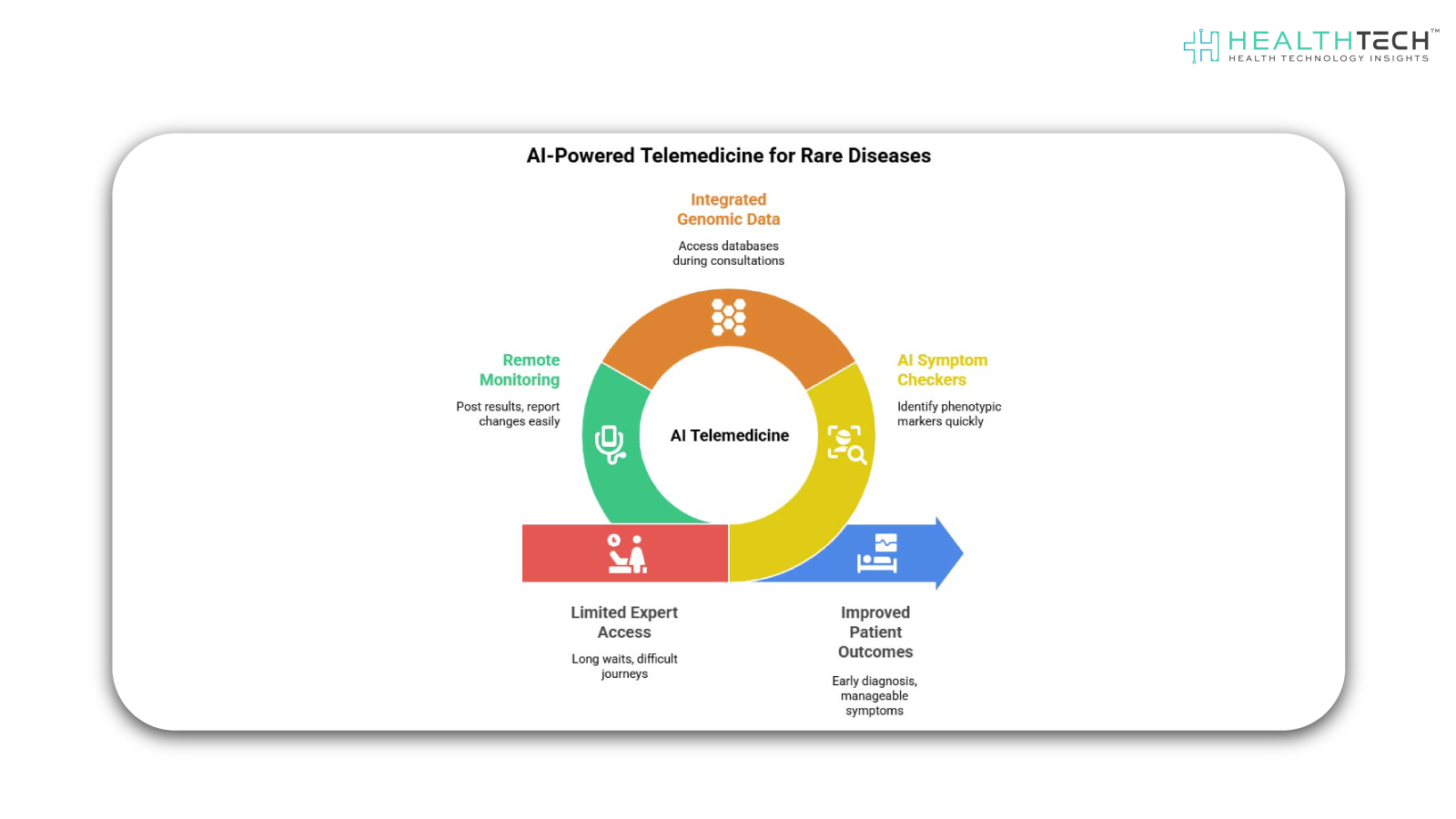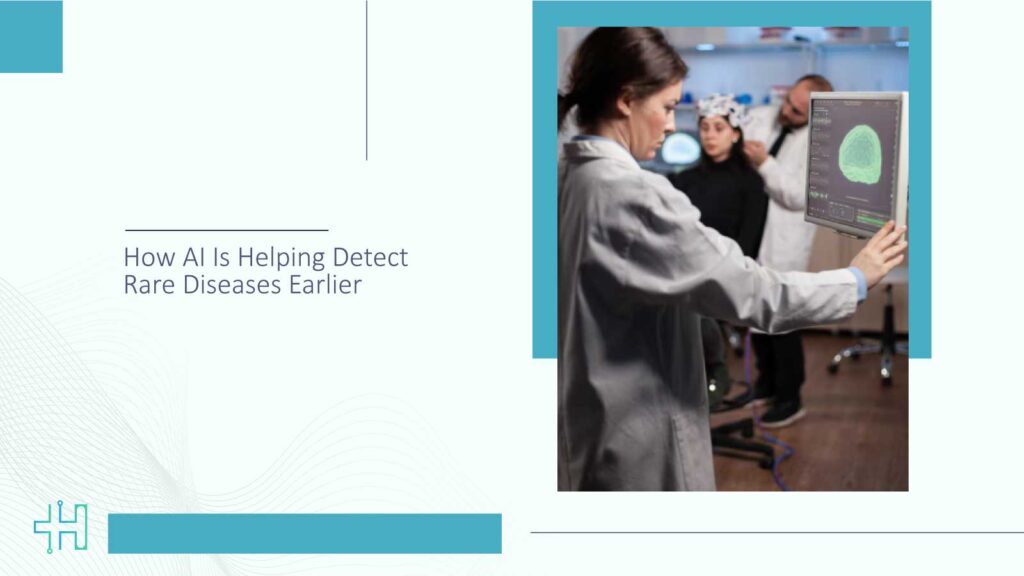Rare diseases afflict about 300 million individuals globally, yet most of them take years to get the right diagnosis. Such a “diagnostic odyssey” usually translates into declining symptoms and limited treatment choices. But now artificial intelligence (AI) is rewriting that story.
By parsing enormous data sets, detecting faint patterns, and joining the dots quicker than humans, AI is making it possible to detect conditions that were once considered almost impossible to catch in time.
In this article, we’ll explore how AI-driven innovations are transforming rare disease diagnostics, the technology powering these breakthroughs, and what this means for healthcare providers and patients alike. Whether you’re a clinician, policymaker, or healthtech innovator, you’ll see how this technology is rewriting the future of early diagnosis.
The Challenge of Rare Disease Diagnosis
Rare diseases are diagnosed as conditions that occur in a small percentage of the population – frequently fewer than 1 in 2,000 people. Each disease is rare, but as a group, they comprise thousands of different conditions. The difficulty is their ambiguity: symptoms tend to be imprecise, overlap with more common illnesses, and may behave erratically.
Traditional diagnostic approaches rely heavily on clinical expertise and trial-and-error testing. This can take years and involve multiple specialists. Research shows that patients with rare diseases wait an average of 4–7 years for a diagnosis.
This delay is costly both financially and in terms of patient health outcomes. AI’s ability to rapidly process diverse medical data is now offering a promising solution to shorten that timeline dramatically.
How AI Is Helping Detect Rare Diseases Earlier Through Pattern Recognition
One of AI’s greatest strengths is identifying patterns invisible to the human eye. By using machine learning algorithms trained on vast datasets including medical records, imaging scans, genetic sequences, and lab results, AI can spot subtle symptom clusters that may indicate a rare condition.
For instance, a patient with ongoing unexplained exhaustion, mild facial feature changes, and some laboratory abnormalities may not cause a suspicion of a rare disease in most physicians. But an AI program having learned from thousands of such cases may bring up the suspicion of a metabolic disorder in seconds. This does not override the doctor’s judgment but serves as a smart assistant, reducing the range of possibilities and encouraging earlier investigations.
AI-Driven Genomic Analysis
Most rare diseases have a genetic basis, and thus genomic sequencing is an important diagnostic tool. But interpreting genetic information is vanishingly complex. AI programs are speeding this process up by comparing a patient’s genome to gigantic global databases of known mutations. Firms such as Fabric Genomics and Diploid have built AI programs that can sequence a whole genome in minutes and report possible disease-causing variants for a clinician’s review.
This acceleration not only conserves time but also enables newborns and even prenatal early intervention. By eliminating the bottleneck of interpretation, AI makes genomic medicine an on-the-spot frontline diagnostic agent instead of a last resort.
Medical Imaging and AI Detection
Radiology is one other area where AI is accelerating and making the detection of rare diseases more accurate. Deep learning algorithms can analyze MRI, CT, or X-ray scans to pick up on abnormalities that might be missed by human radiologists, particularly when the patient has a subtle or unusual presentation.
For instance, AI-based imaging has helped identify early symptoms of pulmonary hypertension – an extremely rare but potentially life-threatening disease by identifying patterns in chest scans that could otherwise be brushed aside as minor abnormalities. Early detection can make a big difference in treatment outcomes, enabling doctors to initiate therapy before permanent damage is done.
One of the most useful applications of AI for rare disease identification is within electronic health record systems. AI can read a patient’s entire medical history – doctor’s notes, medications, tests, and identify instances where the convergence of symptoms points toward a rare condition.
For example, Boston Children’s Hospital uses AI-powered EHR solutions that alert doctors when a patient’s history aligns with patterns of rare diseases. By doing so earlier, patients are sent to specialists earlier, lowering unnecessary tests and visits to the hospital and accelerating diagnosis.
AI and Telemedicine: Increasing Access to Early Detection

In most areas, rare disease experts are in short supply, and the patients must go on long journeys or wait extended periods. Telemedicine solutions with AI are filling the gap by incorporating sophisticated diagnostic equipment directly into online consultations.
With symptom checkers powered by AI, phenotypic marker-identifying facial recognition technology, and access to genomic databases integrated into telemedicine consultations, these sessions can now deliver initial diagnoses previously available only in large medical facilities. This is particularly useful in remote or underserved communities, where acting early can be the difference between symptoms being maintained at a manageable level and their unidirectional progression towards untraversable paths.
Additionally, AI in telemedicine enables ongoing monitoring after diagnosis. Patients can post test results, report symptom changes, and receive alerts from AI when their condition indicates a change – all remotely. This not only enhances results but also renders rare disease treatment more patient-focused.
Ethical Considerations and Challenges
Though the possibilities are vast, applying AI to rare disease diagnosis is not without its difficulties. Data privacy is a leading issue, given that training AI models necessitates large collections of sensitive patient data. Incorrect predictions can also be caused by bias in datasets, especially for minority populations.
Moreover, AI should support, not replace, clinical decision-making. Overreliance on algorithms without human oversight could lead to misdiagnosis or inappropriate treatment. The future will require balanced frameworks that combine AI’s speed with the nuanced judgment of medical professionals.
The Future Outlook
In the future, AI for rare disease diagnosis will probably become increasingly specific and available. Federated learning improvements will enable AI systems to learn from data across multiple institutions without infringing on patient privacy. Remote monitoring devices and wearable technology may also input real-time health data into AI systems, identifying early warning signs far earlier than when a patient sets foot in a clinic.
In brief, the era of multi-year diagnostic odysseys can be replaced with weeks or even days by AI-driven innovation soon.
A Breakthrough in Rare Disease Care
AI is revolutionizing the rare disease landscape by significantly narrowing the time from initial symptoms to confirmed diagnosis. From genomics analysis to imaging interpretation, EHR alerts to telemedicine integration, AI provides a multi-faceted approach that supports clinical acumen.
For clinicians, adopting these tools provides patients with quicker answers and improved treatment options. To patients and families, it is hope and potentially reengineering their medical history. See more innovations such as this at Health Technology Insights and stay on top of healthcare technology.
FAQs
1. What is the primary function of AI in detecting rare diseases?
AI reads vast amounts of data, such as genetic, imaging, and health records data, to identify patterns that could show the presence of a rare disease sooner than conventional means.
2. Will AI substitute physicians in diagnosing rare diseases?
No. AI assists physicians with quicker, data-based insights but human judgment is necessary for ultimate diagnosis and treatment planning.
3. How accurate is AI in identifying rare diseases?
Precision relies on training data quality and diversity. Most AI models are highly precise in research but need frequent validation in the real world of clinical practice.
4. Is rare disease detection through AI accessible globally?
Adoption varies geographically. While affluent health systems are embracing AI technology, access in low-resource environments remains an issue.
5. What is the future of AI for rare disease care?
Look for integration with wearable technology, better data-sharing structures, and even earlier diagnosis through constant monitoring of health.
Keep reading on Health Technology Insights.
To participate in our interviews, please write to our HealthTech Media Room at sudipto@intentamplify.com





